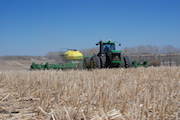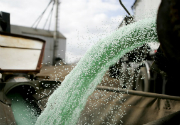| |
| |
 |
| |
 |
|
MMMM d, yyyy |
|
| |
Many areas saw the snowpack almost completely melt or lost to sublimation in January due to above normal temperatures. This melting of snowpack would have saturated the soil surface, reducing the infiltration capacity available for the melt of any late season snow.
» Read more...
The province’s wheat farmers will pay nine cents per tonne less on a single wheat check-off of $1.09 beginning in August 2017. The move to a single wheat check-off is part of the Alberta Wheat Commission’s plan to assume the funding obligations of the Western Canadian Deduction.
» Read more...
By using a clever combination of two inexpensive additives to a spray, MIT researchers found they can drastically cut down on the amount of liquid that bounces off of plants, reducing pesticide or other treatment runoff.
» Read more...
|
| |
 |
 |
| |
|
| |

No other Group 2 herbicide offers the kind of relentless, Flush after flush™ control you’ll get with EVEREST® 2.0. It doesn’t just get the weeds you see, it gets the weeds you know are coming. EVEREST 2.0 delivers superior control of troublesome flushing weeds like wild oats (including Group 1 resistant biotypes). In addition, you get key grass and broadleaf weeds like green foxtail, Japanese brome, tame oats, plus six broadleaf weeds. It works the first time, every time. And it keeps on working with long-lasting, Flush after flush control, reducing the need for an extra pass through the field.
Evolve your farm. |
| |
|
| |
 Based on survey data, canola produced in Alberta (44.6 bushels per acre, or bu/ac) averaged 23 per cent greater than canola produced in southern Saskatchewan (36.3 bu/ac), 10 per cent greater than canola produced in northern Saskatchewan (40.5 bu/ac), and 59 per cent greater than canola produced in Manitoba (28 bu/ac).
» Read more...
Based on survey data, canola produced in Alberta (44.6 bushels per acre, or bu/ac) averaged 23 per cent greater than canola produced in southern Saskatchewan (36.3 bu/ac), 10 per cent greater than canola produced in northern Saskatchewan (40.5 bu/ac), and 59 per cent greater than canola produced in Manitoba (28 bu/ac).
» Read more... |
| |
 If you want to – or have to – store your grain into the summer, what are the best practices to prevent spoilage? Recently completed Prairie research gives a straightforward answer to that question. The initial catalyst for this research was a bumper crop in 2013 followed by grain marketing and transportation issues in 2014. As a result, many Prairie farmers were looking at storing their grain into the summer of 2014.
» Read more...
If you want to – or have to – store your grain into the summer, what are the best practices to prevent spoilage? Recently completed Prairie research gives a straightforward answer to that question. The initial catalyst for this research was a bumper crop in 2013 followed by grain marketing and transportation issues in 2014. As a result, many Prairie farmers were looking at storing their grain into the summer of 2014.
» Read more... |
| |
|
| |
 Conventional nitrogen sources can be affected by circumstances out of your control. Stop letting weather conditions cut into your schedule and your bottom line. Stop losing nitrogen and time by switching to a smarter nitrogen that responds to the same conditions that spur plant growth.
» >>Learn More
Conventional nitrogen sources can be affected by circumstances out of your control. Stop letting weather conditions cut into your schedule and your bottom line. Stop losing nitrogen and time by switching to a smarter nitrogen that responds to the same conditions that spur plant growth.
» >>Learn More |
|
 Supplying crops with the optimum amount of nitrogen can be difficult, especially with constantly changing variables like weather and soil content. And with the vast amount of land growers work with, it’s nearly impossible to know how crops are responding to nutrients at all points in the growth and uptake cycle – unless they have access to a UAV (unmanned aerial vehicle, or drone).
» >>Learn More
Supplying crops with the optimum amount of nitrogen can be difficult, especially with constantly changing variables like weather and soil content. And with the vast amount of land growers work with, it’s nearly impossible to know how crops are responding to nutrients at all points in the growth and uptake cycle – unless they have access to a UAV (unmanned aerial vehicle, or drone).
» >>Learn More |
| |
 |
 |
| |
|
| |
|
|
| |
| |










